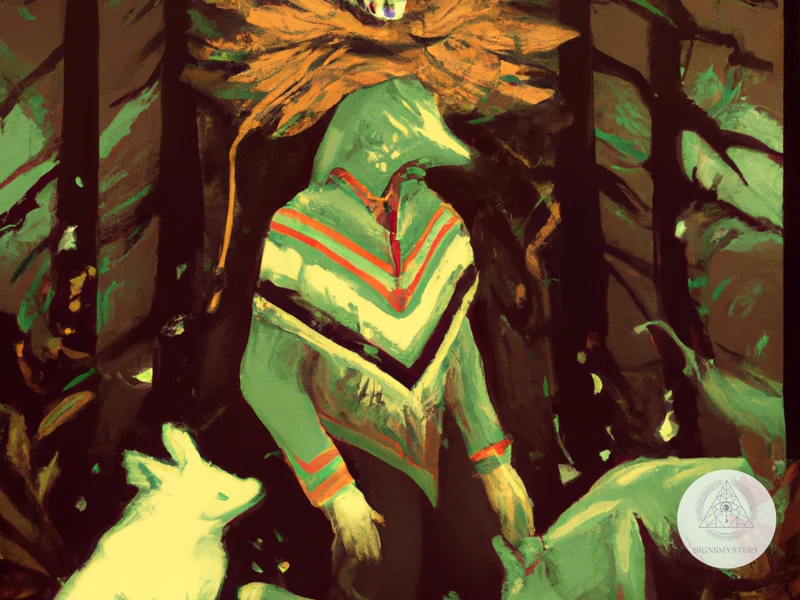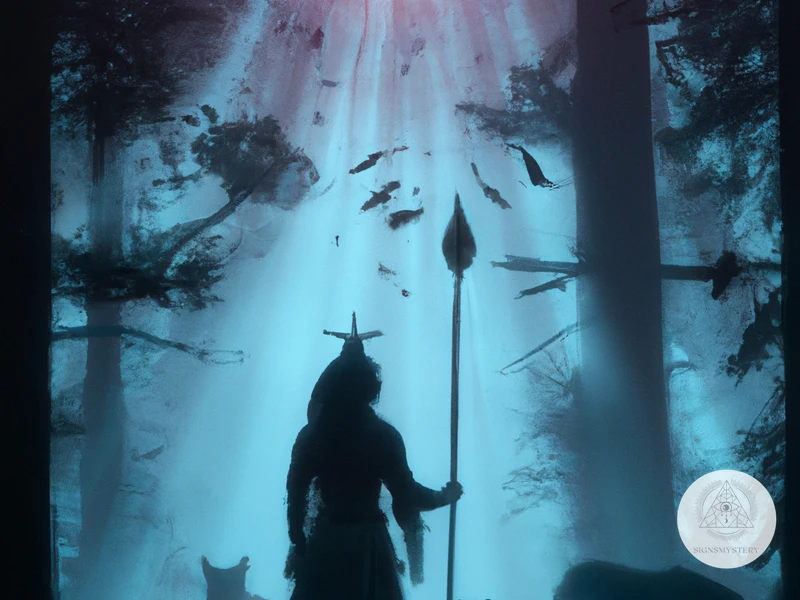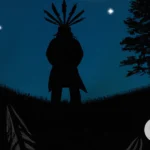Shamanic folktales have been passed down through generations in traditional cultures, playing a vital role in shaping social and spiritual beliefs. The richness of these stories lies in their ability to convey important moral messages through vivid descriptions and symbolism. In this article, we will explore the fascinating history of shamanism, its spread across the world, and the significance of shamanic folktales in traditional cultures. We will delve into the common themes and messages found in these stories, as well as their importance in shaping cultural norms and beliefs. Additionally, we will examine how these stories continue to be relevant today, both in their original contexts and in modern interpretations. So, let’s journey into the realm of shamanic folktales and discover the profound lessons they hold.
The History of Shamanism

Shamanism is one of the oldest religious and spiritual practices in the world. It is believed to have originated in Siberia and spread throughout Asia, Europe, and North America over thousands of years. Shamanism is based on the belief that everything in the world has a spirit or energy, and shamans are individuals who can communicate with these spirits to obtain knowledge and guidance. The practice involves various rituals, including using natural substances for healing, performing ceremonies, and entering trance-like states. The history of shamanism is complex and varied, with different traditions and practices evolving over time in different parts of the world. However, the core belief in the power of spirits and the ability to communicate with them remains consistent across cultures. To understand shamanism fully, we must also examine the role of shamanic folktales, which provide insight into the culture and beliefs of traditional societies.
The Origins of Shamanism
The origins of shamanism can be traced back tens of thousands of years, making it one of the oldest spiritual practices in the world. It is believed that shamanism originated in Siberia, where it was practiced by the Tungus people. From there, the practice spread to other parts of Asia, Europe, and eventually, the Americas.
Shamanism is rooted in the belief that there is a spiritual world that is intertwined with the physical world. Shamans are individuals who are believed to have the ability to communicate with the spirits in this realm. They are often called upon to help heal the sick, offer guidance, and perform other important tasks within their communities.
One theory about the origins of shamanism is that it emerged as a response to the challenges that early humans faced as they began to develop agriculture and settle in one place. With this new way of life came diseases, crop failures, and other problems that humans did not know how to address. Shamans arose as a way for communities to access spiritual guidance and healing that could help them overcome these challenges.
Another theory is that shamanism emerged as a way for people to cope with the harsh realities of life in the natural world. Shamanic practices often involve connecting with nature and the spirits that are believed to reside there. This connection may have helped early humans to feel more secure in the face of dangers like predators, harsh weather, and natural disasters.
Ultimately, the origins of shamanism are difficult to trace with certainty, as the practice predates written history. However, it is clear that shamanism has played an important role in the lives of countless communities throughout history, and continues to do so today.
Click here to learn more about shamanism’s connection to mythology and folktales.
The Spread of Shamanism
Shamanism is a spiritual practice that can be found in many parts of the world. It originated in different cultures independently, including in Asia, Africa, Europe, and the Americas. This spiritual practice was commonly practiced in small, isolated communities. Shamanism allowed individuals to access the spiritual world to help treat illnesses or other problems that arose in their communities.
One of the most important factors in the spread of shamanism was migration. As people migrated from one region to another, they brought their spiritual beliefs and practices with them. For example, shamanic practices in the indigenous communities of North America spread as people moved from east to west. Those who practiced shamanism moved with their tribes and continued their spiritual practices in new territories, where they interacted and sometimes even traded with other groups.
Another factor that contributed to the spread of shamanism was the process of syncretism. Syncretism is the blending of different cultures and beliefs over time. As different cultures interacted with one another, they began to share certain beliefs and practices. This process led to the blending of shamanic practices with other spiritual practices, such as Christianity or Islam, forming unique religious syncretisms, such as syncretism of shamanism with Christianity in Siberian culture.
It is crucial to note that shamanic practices varied between different cultures. However, some commonalities existed, such as the belief in a spiritual realm, the use of power symbolism, and the use of rituals to help individuals enter into the spiritual world.
The spread of shamanism was not accomplished through a unified movement or the establishment of a single institution. In contrast, it was a natural process that expanded in many different ways. Today, people continue to be drawn to shamanic practices because they provide a sense of healing, spirituality, and a connection to their ancestors and the natural world. In the next section, we will explore shamanic folktales and the significant role they play in traditional cultures.
Shamanic Folktales
Shamanic folktales are a rich source of history and tradition that have been passed down orally for centuries in various cultures around the world. These stories use symbolic language and imagery to convey important messages about the world, nature, and human behavior. They are deeply rooted in shamanic practices, which aim to connect individuals with the spiritual world and heal the body, mind, and soul. One of the essential components of shamanic folklore is its symbolic meaning. Symbols are used to represent complex concepts and ideas that would be challenging to express in words. The use of symbols in shamanic folktales is vital in conveying the hidden meanings of the stories. The retelling of these stories is also a crucial factor in the preservation of shamanic culture, and the art of retelling folklore is valued and respected in many traditional societies.
What Are Shamanic Folktales?
Shamanic folktales are traditional stories that have been passed down through generations in cultures with a shamanic tradition. These stories are often told in an oral tradition and are known for their use of symbolism and metaphor. Shamanic folktales are believed to hold hidden wisdom that can help people connect with the spiritual realm and gain a deeper understanding of the natural world.
Shamanic folktales typically revolve around a shamanic journey or a spiritual quest. The protagonist of the tale goes on a journey into the spirit world where they encounter various challenges and obstacles. Through their journey, they gain insight into their own lives and the world around them.
These tales are often deeply symbolic, featuring characters and objects that represent important concepts and ideas in the shamanic tradition. For example, animals are often used symbolically in shamanic folktales. The fox, for example, may represent cunning and intelligence, while the bear may represent strength and courage.
Additionally, shamanic folktales often feature powerful imagery and vivid descriptions of the natural world. This is because many traditional shamanic cultures believe that all things in the natural world have a spiritual essence and that everything is interconnected.
Shamanic folktales are an important part of shamanic tradition. They serve as a way for people to connect with the spiritual realm and gain a deeper understanding of the natural world. Through the use of symbolism and metaphor, these stories offer hidden wisdom and insight into the human experience. If you want to learn more about the power of symbolism in shamanic folktales, you can read our article “/power-symbolism-shamanic-folktales/” on the topic.
Why Are Shamanic Folktales Important?
Shamanic folktales hold a deep significance in traditional cultures for many reasons. These stories are not only a source of entertainment but play a vital role in recording and preserving the cultural history of societies. These folktales depict the ways of living, customs, rituals, and beliefs of people and communities that have been passed down from generation to generation.
Shamanic folktales serve as a means of communicating important life lessons and moral values. They often feature characters who embody particular virtues and teach listeners through their actions and experiences. This allows the listeners to understand and relate to the underlying messages easily.
Shamanic folktales also play an essential role in the development of the human psyche. They are often used as a tool of psychological healing and transformation. The surreal and vivid imagery in the stories creates powerful and cathartic experiences for the listener, which helps them connect with the spiritual and emotional world in a profound way.
These stories help maintain and strengthen the social fabric of traditional communities. They provide a shared set of cultural values, common discourse, and a sense of belonging. This shared cultural identity helps to create a cohesive and strong community, which is essential in times of difficulty.
Shamanic folktales are crucial to traditional cultures’ survival, serving as a way to pass on essential cultural knowledge and wisdom, teach moral values, develop the psyche, and create a sense of community. Their importance cannot be overstated.
What Are the Common Themes in Shamanic Folktales?
Shamanic folktales have a rich history and are an important part of traditional cultures. These tales are often passed down orally from generation to generation, and some common themes can be found across different cultures. Some of the common themes in shamanic folktales are:
| Theme | Description |
|---|---|
| The Hero’s Journey | The hero’s journey is a common theme in shamanic folktales. It usually involves a young hero or heroine who embarks on a perilous journey to overcome challenges and find their place in the world. This journey often involves encountering supernatural beings and gaining knowledge or power from them. |
| Trickster Tales | Trickster tales are stories that feature a character who uses their wit and cunning to outsmart others. The trickster can be a god, animal, or human, and is often portrayed as mischievous and playful. These tales often have a moral lesson or serve to explain natural phenomena. |
| Creation Stories | Creation stories are tales that explain how the world and its inhabitants came to be. These stories often involve gods or supernatural beings and can vary greatly across cultures. They offer insight into the values, beliefs, and cosmology of a particular culture. |
| Nature Tales | Nature tales are stories that feature animals or supernatural beings that inhabit the natural world. These tales often have a moral lesson or serve to explain natural phenomena. They reflect a culture’s relationship with the environment and offer insight into their spiritual beliefs. |
| Myths of the Afterlife | Myths of the afterlife are tales that explore what happens to the soul after death. These stories often involve a journey to the underworld and encounters with supernatural beings. They offer insight into a culture’s beliefs about death, the soul, and the afterlife. |
These common themes can be found in shamanic folktales across different cultures, highlighting the universal themes that connect us all. They provide insight into the values, beliefs, and cosmology of traditional cultures, and continue to have relevance today.
The Role of Shamanic Folktales in Traditional Cultures

Shamanic folktales play a crucial role in preserving the cultural heritage and moral values of traditional societies. Passed down from generation to generation, these stories contain important messages and teachings that guide individuals in their daily lives. In many traditional cultures, shamans or medicine men/women are considered the keepers and interpreters of these stories, which often include spiritual and supernatural elements. The cultural significance of these tales lies in their ability to connect individuals to their ancestral roots and offer insight into their worldview and beliefs. Socially, these tales can serve as a means of community building and reinforcing shared values. Spiritually, they can offer guidance on how to live in harmony with nature and the spirit world. The enduring relevance of shamanic folktales today is that they continue to offer valuable insights and lessons, particularly in areas such as environmental awareness and spiritual development.
The Cultural Significance of Shamanic Folktales
One of the most significant aspects of Shamanic Folktales is their cultural significance. These tales reflect the values, beliefs, and way of life of the community they belong to. They are a way of preserving cultural traditions and passing them down to future generations. By sharing these stories with one another, communities create a collective identity and strengthen their sense of connection to their culture.
Shamanic Folktales provide a window into the worldviews of the cultures they originate from, giving insight into their understanding of the natural world, social relationships, and spirituality. For instance, tales about the natural world and animals can reveal cultural attitudes towards nature and the human place in the environment. Meanwhile, stories about human relationships and social roles can illustrate cultural norms and expectations.
Shamanic Folktales can also play a significant role in cross-cultural understanding, helping people from different communities and backgrounds empathize with one another and find common ground. By studying and understanding the values and beliefs expressed in these tales, we can better appreciate the diversity of humanity and promote cross-cultural awareness and appreciation.
Ultimately, Shamanic Folktales are a vital part of many cultures, reflecting and reinforcing the cultural identity and values of the communities they belong to, while also offering insight into the human experience and fostering cross-cultural understanding and empathy.
The Social Relevance of Shamanic Folktales
Shamanic folktales have played a significant role in shaping
Subscribe to Our Newsletter
Sign up to receive the latest news and updates.
One of the key ways in which shamanic folktales are socially relevant is by fostering a sense of community. These stories often revolve around the experiences of a hero or protagonist who faces adversity and overcomes it through the support of their community. This highlights the importance of interdependence and cooperation in achieving goals, thus promoting a strong sense of communal identity and responsibility.
Shamanic folktales often reinforce traditional gender roles and norms. Women are often portrayed as nurturing and compassionate, while men are depicted as brave and resourceful. These roles and expectations are reinforced through the storytelling and serve to solidify them within the community, promoting social order and stability.
Shamanic folktales also serve as a warning against deviant behavior and encourage adherence to societal norms. By emphasizing the consequences of selfish or irresponsible actions, these tales reinforce the idea that individual actions have an impact on the community as a whole. This promotes a sense of social responsibility and encourages individuals to act in the best interest of the group.
Shamanic folktales have played a significant role in shaping the social norms and expectations of traditional cultures. By promoting a sense of community, solidifying traditional gender roles, and encouraging adherence to societal norms, these tales have been instrumental in maintaining social order and stability. Their enduring relevance speaks to their power as a tool for socialization and identity formation.
The Spiritual Meaning of Shamanic Folktales
Shamanic folktales hold great spiritual significance in traditional cultures. These stories are often used to impart spiritual wisdom and teach valuable life lessons that are rooted in the belief systems of the cultures in which they originate.
Symbolism is an essential component of shamanic folktales. Characters and objects in these stories are often imbued with deep symbolic meaning, which is used to convey spiritual messages to the listener or reader.
For example, in some shamanic folktales, animals play a central role and are used to represent different aspects of the human experience. The bear, for instance, is often used to symbolize strength, courage, and power. The snake, on the other hand, is often used to represent transformation, rebirth, and healing.
The spiritual meaning of shamanic folktales is also closely tied to their function as tools for ritual and ceremony. Many of these stories are used in specific ritual contexts, such as healing ceremonies or rites of passage, and are believed to have the power to connect the listener or reader with the spiritual realm.
In addition to their use in ritual, shamanic folktales are also used as tools for personal growth and transformation. They are often intended to inspire the listener or reader to reflect on their own lives and actions, and to strive for greater spiritual awareness and enlightenment.
One common theme in shamanic folktales is the idea of interconnectedness. These stories often emphasize the importance of recognizing that all living beings are connected and that every action has a ripple effect on the world around us. This idea of interconnectedness is central to many spiritual belief systems and is often used as a call to action for listeners or readers to live in harmony with the world around them.
The spiritual meaning of shamanic folktales is complex and multifaceted. These stories not only serve as a means of imparting spiritual wisdom and teachings but also play a vital role in connecting individuals to their spiritual roots and facilitating personal growth and transformation.
The Enduring Relevance of Shamanic Folktales Today
As our society advances technologically, it’s easy to dismiss shamanic folktales as outdated and irrelevant. However, their enduring relevance speaks to their importance in understanding humanity’s collective consciousness. The lessons we can derive from these tales are timeless and universal, providing insight into our fundamental desires, fears, and values. Today, shamanic folktales have found a renewed significance in modern contexts such as psychotherapy, where they are used to explore the human psyche and promote healing. Even in our fast-paced, rational world, shamanic folktales continue to captivate and enchant audiences, reminding us of the enduring power of storytelling and the universality of the human experience.
How Shamanic Folktales Are Used in Modern Contexts
How Shamanic Folktales Are Used in Modern Contexts:
Shamanic folktales, despite their ancient origin, are still relevant in modern times. Many cultures, both indigenous and non-indigenous, still use shamanic folktales as a source of wisdom and inspiration.
One way shamanic folktales are used in modern contexts is through their incorporation into various forms of art. Visual artists, musicians, and writers often draw on shamanic folktales to create new works of art that resonate with contemporary audiences. For example, many modern films and TV shows incorporate shamanic themes and motifs.
Another way shamanic folktales are used in modern contexts is through their application in therapeutic settings. Some therapists use shamanic storytelling as a way to help patients process trauma and emotional pain. The stories can provide a sense of comfort and guidance that helps individuals heal and strengthen their connection to their inner selves.
Shamanic folktales are employed in educational contexts as well. Some educators use these stories as a way to teach children lessons about the natural world and how to live in harmony with it. These stories often contain important messages about environmental stewardship and the interdependence of all living things.
In business contexts, shamanic folktales can be used as a source of inspiration for leaders and corporate executives. Stories of resilience, courage, and innovation from traditional cultures can be applied to modern business challenges, offering creative solutions that may not have been otherwise considered.
Shamanic folktales have enduring relevance in modern contexts. Whether used in the arts, therapy, education, or business, these stories continue to inspire and guide people today. Their timeless wisdom and universal themes make them a valuable source of insight for anyone seeking to connect with their inner selves, their community, and the natural world.
The Lessons We Can Learn from Shamanic Folktales
The lessons we can learn from shamanic folktales are numerous and varied. These stories usually have a heroic character or characters who face various challenges and obstacles, both natural and supernatural, and ultimately emerge triumphant. Here are some of the lessons that we can learn from these tales:
| Lesson | Description |
|---|---|
| Respect for Nature | Many shamanic folktales illustrate the interconnectedness of humans and nature, and the importance of respecting and protecting the environment. |
| Perseverance | Most shamanic tales involve characters who face challenges and adversity but overcome them through sheer perseverance, determination, and willpower. |
| Community Values | Shamanic stories often emphasize the importance of community, cooperation, and solidarity in facing challenges and achieving collective goals. |
| Moral Lessons | Many shamanic folktales contain moral lessons and teachings that guide ethical behavior and decision-making, such as honesty, fairness, and empathy. |
| Spirituality | Shamanic tales often convey spiritual concepts and beliefs, such as the existence of an unseen realm, the power of ritual and prayer, and the connection between all living beings. |
These lessons are still relevant today, as we face global environmental challenges, political and social unrest, and personal struggles. By learning from these timeless stories, we can tap into the wisdom, strength, and resilience of our ancestors and apply it to our modern lives.
Conclusion
In conclusion, shamanic folktales hold immense importance in traditional cultures due to their cultural, social, and spiritual relevance. Through these tales, important cultural values, beliefs, and practices are transmitted across generations. They also serve as a means of socialization, as children are taught to follow certain moral codes and norms through these stories. Furthermore, these tales give individuals a sense of spiritual identity, connecting them with their roots and the natural world.
Despite the impact of modernization and globalization, shamanic folktales have continued to remain relevant and are still being used in contemporary contexts. These tales are adapted and reinterpreted to fit modern issues such as environmental conservation and social justice.
It is important that we continue to value and preserve shamanic folktales for future generations. By learning from these stories, we can gain insights into our collective histories, cultures, and spiritualities, as well as broaden our perspectives on the world we live in. Let us celebrate the beauty and richness of shamanic folktales and carry their wisdom with us into the future.
Frequently Asked Questions
What is the definition of Shamanism?
Shamanism is a practice that involves connecting to the spiritual world through altered states of consciousness, often with the help of a shaman or spiritual leader.
What are some common themes in Shamanic Folktales?
Common themes in Shamanic Folktales include the importance of nature, the struggle between good and evil, and the power of transformation and rebirth.
How did Shamanism spread throughout different cultures?
Shamanism spread through different cultures through migration, trade, and cultural exchange. It also adapted and evolved to fit the needs of each specific culture.
Why are Shamanic Folktales important in traditional cultures?
Shamanic Folktales are important because they provide a way to pass down ancient knowledge, traditions, and beliefs to future generations. They also serve as a way to reinforce cultural values and reinforce social constructs.
What is the role of Shamanic Folktales in modern culture?
Shamanic Folktales can still teach valuable lessons in modern culture, such as the importance of connecting to nature and the power of transformation. They can also provide insight and guidance for personal growth and spirituality.
How are Shamanic Folktales used in therapy?
Shamanic Folktales can be used in therapy to help clients explore their own personal struggles and connect to their own inner wisdom. They can also be used as a way to provide comfort and healing.
What are the benefits of exploring Shamanic Folktales?
Exploring Shamanic Folktales can provide a deeper understanding of different cultures and spiritual practices, as well as provide insights into personal growth and transformation.
Can Shamanic Folktales be used in storytelling or art?
Yes, Shamanic Folktales can be used in storytelling or art to share these ancient stories and inspire creativity.
How do Shamanic Folktales relate to environmentalism?
Shamanic Folktales often emphasize the importance of connecting to and respecting nature. This can foster a sense of environmentalism and a desire to protect our natural world.
What impact do Shamanic Folktales have on communities?
Shamanic Folktales can help build a sense of community and shared values. They can also provide guidance and support during difficult times and serve as a way to reinforce cultural identity.










